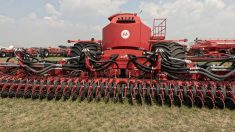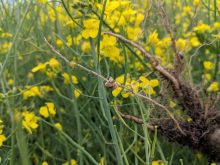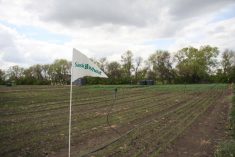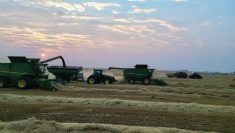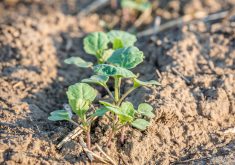Allan Anderson is a big fan of concentrated seed treatments.
“I would love to see every single product as a concentrate because that allows so much flexibility with overall application,” says Anderson, senior seed growth specialist with Bayer.
Anderson thinks that more concentrate products will enter the seed treatment market as formulations and active ingredients evolve. “And overall it’s going to work out well for everybody.”
Bayer has a concentrated fungicide seed treatment, Trilex EverGol, for pulses such as peas, lentils, chickpeas and fababeans. Active ingredients include penflufen (Group 7), trifloxystrobin (Group 11) and metalaxyl (Group 4). It covers rhizoctonia, ascochyta, botrytis, fusarium and pythium.
Read Also

Claas brings 1000 Series SP forage harvesters to Canada
In mid-August, Claas unveiled its new line of Jaguar forage harvesters at an event in Visalia, California, deep in the heart of that state’s dairy region.
Trilex EverGol can be applied on farm or commercially. The cost per acre is “virtually the same” as a ready-to-use product, says Anderson.
The pros of concentrates
Concentrates have been on the market for commercial application for quite a while, says Anderson. There were also concentrates for cereals 10 or 15 years ago.
“But some of the early concentrates had problems with adherence to seed,” Anderson says. “They dusted off very easily. They weren’t the easiest to work with.”
Since then, concentrate formulations have improved. “These products stay where they’re supposed to be. They stay on the seed,” says Anderson.
These days there are more seed treatment concentrates hitting the market. Trilex EverGol has been out for about five years. Anderson says it’s a big improvement over its predecessor, Trilex AL. Anderson describes Trilex AL as thick, goopy and hard to apply. Trilex EverGol is much easier to apply, he says.
Typically Trilex EverGol is diluted with water at a seven-to-one ratio. That creates a water-like solution when it’s applied to the seed, says Anderson. And that makes it less vulnerable to temperature variances and humidity than a ready-to-use product, where “basically you take it or you leave it.”
For years, the industry has produced ready-to-use products that don’t require dilution. That simplifies things for busy farmers during spring seeding. However, ready-to-use products create large quantities to transport and handle, Anderson says.
Concentrates come in smaller packages, making them easier to handle, says Anderson. “You don’t need a forklift. You just put a couple of cases in your hand and you walk across the yard, so to speak. And they treat a large volume of seed.”
Shelby Reid is an agronomist with Sturgeon Valley Fertilizer in Alberta. Reid treats fababean and pea seed with a mobile Storm Treater for customers. Overall Trilex EverGol is easy to use and handle, she writes via email. It’s also one of the most popular seed treatments that she applies for customers.
“The concentrated packaging is easy to handle and there is less packaging to deal with,” says Reid, adding that compared to ready-to-use treatment, she only transports about an eighth of the product to do the same number of bushels.
Tailored applications
Concentrates can also be a bit more flexible. Anderson explains that a concentrated formulation allows farmers to tailor application rates by adjusting overall water volume or using something like a seed-applied nutrient as carrier. The key is to make sure the amount of active ingredient going on the seed per 100 kg is correct, he adds.
For example, if a farmer wanted to apply a nutrient to a ready-to-use seed treatment, the overall application volume would be around 650 ml, creating “a fairly wet pulse seed,” says Anderson. That’s a problem because it usually takes longer for seed treatments to dry on pulses, he says.
But Trilex EverGol’s concentrated application rate is 41 ml/100 kg of seed. Assuming the application rate of the nutrient is 325 ml/100 kg, that creates an overall application rate of 366 ml. “And things work really nice.”
There are also a couple of liquid inoculants that can be tank mixed with Trilex EverGol, says Anderson. He notes that farmers tank mixing liquid inoculants with any seed treatment should check compatibility ratings. Compatibility with peat and granular inoculants isn’t an issue for Trilex EverGol, he adds.
Using polymers as a carrier also works well, says Anderson. Polymers are typically used when applying inoculants. They serve as a food source for the rhizobia, a seed treatment carrier, and as another layer on the seed coat.
“Polymers tend to extend the ‘on-seed’ rhizobia safety time prior to planting, thus creating a longer treat-to-plant window,” says Anderson.
Anderson says farmers and agronomists can also add water to these carriers for chickpeas. Because pulse seeds vary in shape, size, and surface area, “we need different volumes to do a good job of coating the seed,” he says.
“And if you do not have good application, it does not matter what kind of seed treatment you’re using.”
Reid primarily works with fababeans and peas, so she sticks to the seven-to-one dilution rate. She said they’ve been happy with the “consistent and even coverage on the seed.” She hasn’t used polymers or liquid inoculants in Sturgeon Valley’s seed treater.
Nor has she used seed-applied nutrients with Trilex EverGol. However, in the past she has treated wheat with both a seed treatment and a nutrient. Those products were applied simultaneously using different nozzles. She hasn’t seen issues with that, although she says that the two crops do handle differently.
“Although I haven’t used a nutrient as a carrier for Trilex, I really like that idea and I definitely see benefits in that system (i.e. not having the seed as wet),” says Reid.
Coincidentally, Reid was meeting Anderson shortly after speaking to Grainews, and she planned to “pick his brain” on using a nutrient carrier with Trilex EverGol.
Concentrate challenges
There are a few challenges and considerations when using concentrate products. Anderson says that farmers don’t always get a clear message about diluting the concentrate from retailers. When they get the product in their hands, they’re confused about how to treat a large volume of seed with what seems like a small amount of product.
Reid says that as a mobile seed treater, she needs to transport water to dilute the concentrated seed treatment. That comes with its own logistical issues around pumps, hoses, and refilling.
Both Reid and Anderson say that farmers using concentrates will need a mixing tank with enough capacity for the diluted formula. The flow rates of nozzles should also be checked, as the product is thinner, Anderson says.
Anderson says some of the new computerized on-farm treaters can handle concentrates more easily, although regular seed-treating equipment should work, as long as the mixing drum has the capacity.
Reid says Sturgeon Valley Fertilizer is set up to handle Trilex EverGol easily. But she does think the need for dilution might be a barrier for some producers looking at on-farm treatment. Concentrated seed treatments require pumps, drums, and calibrated equipment, she says.
“From my experience growers who treat on farm tend to lean towards ready-to-use formulations as it is one less thing for them to think about in the already busy spring,” says Reid.





